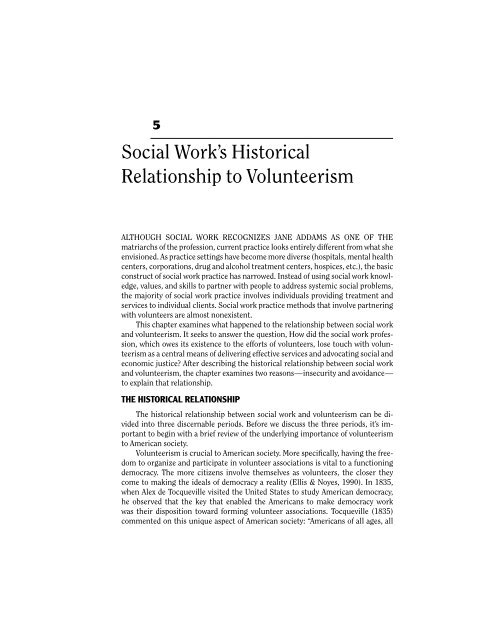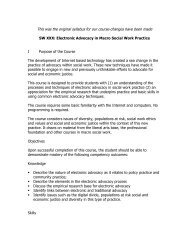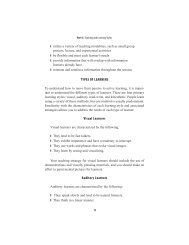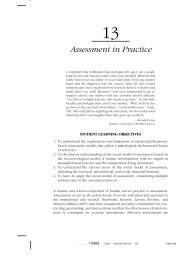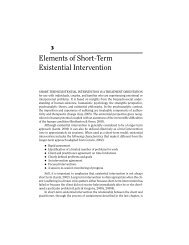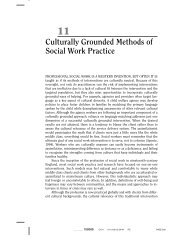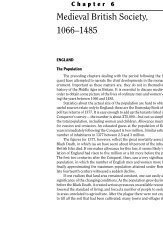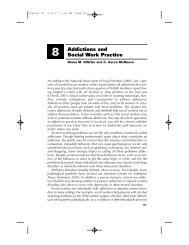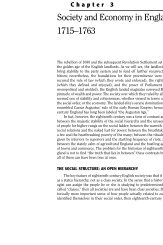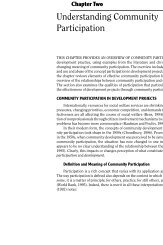Social Work's Historical Relationship to Volunteerism - Lyceum Books
Social Work's Historical Relationship to Volunteerism - Lyceum Books
Social Work's Historical Relationship to Volunteerism - Lyceum Books
Create successful ePaper yourself
Turn your PDF publications into a flip-book with our unique Google optimized e-Paper software.
5<br />
<strong>Social</strong> Work’s <strong>His<strong>to</strong>rical</strong><br />
<strong>Relationship</strong> <strong>to</strong> <strong>Volunteerism</strong><br />
ALTHOUGH SOCIAL WORK RECOGNIZES JANE ADDAMS AS ONE OF THE<br />
matriarchs of the profession, current practice looks entirely different from what she<br />
envisioned. As practice settings have become more diverse (hospitals, mental health<br />
centers, corporations, drug and alcohol treatment centers, hospices, etc.), the basic<br />
construct of social work practice has narrowed. Instead of using social work knowledge,<br />
values, and skills <strong>to</strong> partner with people <strong>to</strong> address systemic social problems,<br />
the majority of social work practice involves individuals providing treatment and<br />
services <strong>to</strong> individual clients. <strong>Social</strong> work practice methods that involve partnering<br />
with volunteers are almost nonexistent.<br />
This chapter examines what happened <strong>to</strong> the relationship between social work<br />
and volunteerism. It seeks <strong>to</strong> answer the question, How did the social work profession,<br />
which owes its existence <strong>to</strong> the efforts of volunteers, lose <strong>to</strong>uch with volunteerism<br />
as a central means of delivering effective services and advocating social and<br />
economic justice? After describing the his<strong>to</strong>rical relationship between social work<br />
and volunteerism, the chapter examines two reasons—insecurity and avoidance—<br />
<strong>to</strong> explain that relationship.<br />
THE HISTORICAL RELATIONSHIP<br />
The his<strong>to</strong>rical relationship between social work and volunteerism can be divided<br />
in<strong>to</strong> three discernable periods. Before we discuss the three periods, it’s important<br />
<strong>to</strong> begin with a brief review of the underlying importance of volunteerism<br />
<strong>to</strong> American society.<br />
<strong>Volunteerism</strong> is crucial <strong>to</strong> American society. More specifically, having the freedom<br />
<strong>to</strong> organize and participate in volunteer associations is vital <strong>to</strong> a functioning<br />
democracy. The more citizens involve themselves as volunteers, the closer they<br />
come <strong>to</strong> making the ideals of democracy a reality (Ellis & Noyes, 1990). In 1835,<br />
when Alex de Tocqueville visited the United States <strong>to</strong> study American democracy,<br />
he observed that the key that enabled the Americans <strong>to</strong> make democracy work<br />
was their disposition <strong>to</strong>ward forming volunteer associations. Tocqueville (1835)<br />
commented on this unique aspect of American society: “Americans of all ages, all
64 Chapter 5 <strong>Social</strong> Work’s <strong>His<strong>to</strong>rical</strong> <strong>Relationship</strong> <strong>to</strong> <strong>Volunteerism</strong><br />
stations in life and all types of dispositions are forever forming [volunteer] associations.<br />
They are not only commercial and industrial associations in which they take<br />
part, but others of a thousand types—religion, moral, serious, futile, very general<br />
and very limited, immensely large and very minute” (p. 485).<br />
The propensity for forming volunteer associations in America began as an effort<br />
for survival. In the seventeenth century, cooperative farm ventures were formed<br />
<strong>to</strong> assist with building construction, collective cattle herding, and labor sharing<br />
(Barck & Lefler, 1958; Earle, 1923). Groups of volunteers would also work <strong>to</strong>gether<br />
<strong>to</strong> erect churches that would function both as places of worship and as meeting<br />
places for all types of community functions (Rines, 1936). Government <strong>to</strong>ok the<br />
form of voluntary <strong>to</strong>wn meetings where unpaid officials were selected <strong>to</strong> fulfill numerous<br />
roles such as clerks of the market, <strong>to</strong>wn criers, and surveyors of the highways.<br />
Although at first volunteer efforts did not formally address organized charity,<br />
as the population increased, benevolent societies formed <strong>to</strong> provide relief <strong>to</strong> the<br />
poor when families were unavailable <strong>to</strong> assist them. As these benevolent societies<br />
failed <strong>to</strong> meet the growing needs of the poor, they eventually began <strong>to</strong> regard the entire<br />
community as ultimately responsible for the care of the unfortunate (Fairlie,<br />
1920). It was through the formation of volunteer associations, therefore, that the<br />
need for community social welfare was recognized.<br />
During the eighteenth and nineteenth centuries, nearly every advance in American<br />
society came about as a result of volunteerism (Berger & Neuhaus, 1977; Ellis<br />
& Noyes, 1990). Volunteer societies formed <strong>to</strong> improve transportation, sanitation,<br />
communication, fire prevention, public safety, and education. Volunteer associations<br />
also advocated fair labor practices, especially concerning children; women’s rights;<br />
African Americans’ rights; better medical practices; and humane treatment of the<br />
mentally ill and brought attention <strong>to</strong> the debilitating effects of alcohol (Carter, 1926;<br />
Cubberly, 1944; Dunlop, 1965; Laidler, 1968). Ellis and Noyes (1990) even go so far<br />
as <strong>to</strong> suggest that nearly every social need recognized and addressed by the government<br />
was first recognized and advocated for by some volunteer effort.<br />
Even the social reform advances of the Progressive Era depended upon the<br />
volunteer collaboration between the lower and middle classes (Hofstadter, 1963).<br />
Whereas their efforts had once been fueled by a need for survival, now the common<br />
thread of their collaboration was humanitarianism. During the Progressive Era, volunteer<br />
efforts worked <strong>to</strong>ward encouraging the government <strong>to</strong> act “upon the public’s<br />
civic alertness and will” (Ellis & Noyes, 1990, p. 168) and <strong>to</strong> temper the zealousness<br />
for economic prosperity with the protection of human rights. As the chapter will<br />
show, however, reformers did not intend for increased professional and government<br />
involvement <strong>to</strong> replace the participation or responsibility of volunteers.<br />
<strong>Volunteerism</strong>: The Origin of <strong>Social</strong> Work<br />
Simply stated, the profession of social work owes its existence <strong>to</strong> volunteerism.<br />
Volunteers founded relief societies, children’s homes, day care programs, recreation
services, family and child welfare associations, and mental health associations. In<br />
other words, volunteers preceded social work in almost every field of practice (Anderson<br />
& Ambrosino, 1992). Many introduc<strong>to</strong>ry texts on social work and social welfare<br />
recognize the profession’s origin in volunteerism. For example, Morales and<br />
Sheafor (2004) describe the beginning of social work as being “found in the extensive<br />
volunteer movement during the formative years of the United States” (p. 40).<br />
Most notably, the contributions of volunteers are recognized as essential <strong>to</strong> the development<br />
of the Charity Organization Society (COS) movement and the settlement<br />
house movement (see, e.g., Ellis & Noyes 1990). It is in these two movements that<br />
the role of volunteerism is linked <strong>to</strong> the emergence of the social work profession.<br />
As a volunteer movement, the COS movement emerged <strong>to</strong> become a significant<br />
precursor <strong>to</strong> social work, representing the first efforts <strong>to</strong> serve poor people in a systematic<br />
way. Essentially the movement consisted of volunteers who assisted families<br />
in meeting their physical, economic, emotional, and spiritual needs. In 1877 the Reverend<br />
S. Humphrey Gurteen established the first COS in Buffalo, New York, <strong>to</strong> provide<br />
an alternative method <strong>to</strong> indiscriminate giving for helping the poor (Pumphrey<br />
& Pumphrey, 1961). The proponents of COS worked <strong>to</strong> make philanthropic practices<br />
more systematic and efficient. The principle method <strong>to</strong> improve efficiency was volunteer<br />
cooperation. COS organizations usually consisted of an executive council of<br />
volunteer leaders who were already actively engaged in providing services <strong>to</strong> the<br />
poor. Moreover, the council trained direct service volunteers, commonly referred <strong>to</strong><br />
as “family visi<strong>to</strong>rs,” <strong>to</strong> screen applicants, conduct family his<strong>to</strong>ries, and manage cases<br />
<strong>to</strong> make informed choices about the best ways <strong>to</strong> provide support (Putnam, 1887).<br />
As discussed in chapter 4, the settlement house movement also emerged from the<br />
efforts of volunteers. As a volunteer member of the Woman’s City Club of Chicago,<br />
Jane Addams turned an old and battered building in<strong>to</strong> Hull-House. The Hull-House<br />
Woman’s Club would become one of the largest women’s volunteer clubs in the city of<br />
Chicago. Addams (1910b) acknowledged the value of the women’s volunteer clubs,<br />
saying, “The entire organization of the social life at Hull House, while it has been fostered<br />
and directed by residents and others, has been largely pushed and vitalized from<br />
within by the club members themselves” (p. 253). More specifically, it was within the<br />
context of her membership in these clubs that Addams was able <strong>to</strong> encourage fellowship<br />
among women of different ethnicities, connect residents of Hull-House with<br />
better housing, and advocate improved conditions within Chicago’s city jails.<br />
<strong>Social</strong> Work’s Attempt <strong>to</strong> Distinguish Itself<br />
Chapter 5 <strong>Social</strong> Work’s <strong>His<strong>to</strong>rical</strong> <strong>Relationship</strong> <strong>to</strong> <strong>Volunteerism</strong> 65<br />
The COS and settlement house movements characterized the shift away from<br />
individual and volunteer philanthropy <strong>to</strong>ward scientific charity. As people such as<br />
Mary Richmond, Josephine Shaw Lowell, Robert Hunter, and Edward Devine recognized<br />
the importance of comprehensive assessments, clear record keeping, and<br />
effective coordination of services, there was a growing recognition of the need for<br />
people <strong>to</strong> be professionally trained <strong>to</strong> work with the poor and needy (Morales &
66 Chapter 5 <strong>Social</strong> Work’s <strong>His<strong>to</strong>rical</strong> <strong>Relationship</strong> <strong>to</strong> <strong>Volunteerism</strong><br />
Sheafor, 2004). Professional training, however, was never intended <strong>to</strong> replace individual<br />
concerns and volunteer efforts. In fact, Mary Richmond (1908) believed that<br />
social workers could never completely stand in as the social servants of the community.<br />
She believed instead that a basic responsibility of the social work profession<br />
was <strong>to</strong> guide and support the efforts of volunteers.<br />
As the delivery of services became more systematic, however, Richmond’s reminder<br />
and Addams’s example of the importance of reciprocal partnerships between<br />
professional helpers and volunteers were quickly forgotten. By the time President<br />
Roosevelt’s administration enacted the New Deal, the government had become primarily<br />
responsible for social welfare services, and social work became the primary<br />
profession in the provision of these services (Ellis & Noyes, 1990; Katz, 1996). Trattner<br />
(1999) summarizes the shift in the relationship this way:<br />
The devaluation of volunteers did not take the form of outright rejection, largely because<br />
of the long tradition of volunteerism in social welfare and because professional<br />
social workers needed the power, influence, and financial help of volunteers. What<br />
occurred, then, was a reversal of roles. Whereas earlier what was considered the real<br />
work of the agency, friendly visiting, was conducted by volunteers and the menial<br />
labor by paid staff members, by the turn of the century, the opposite was beginning <strong>to</strong><br />
occur; volunteers did the office work or, by serving as trustees helped shape policy and<br />
raise funds, while the work in the field, casework, was in the hands of paid professional<br />
agents. Viewed earlier as a civic duty, volunteerism became, instead, a privilege<br />
granted by agencies <strong>to</strong> those who accepted their authority and discipline. (p. 103)<br />
Reconciliation in Times of Need<br />
Of course, the social work profession did not abandon ties with volunteerism<br />
al<strong>to</strong>gether. Instead, as Trattner (1999) points out, the relationship shifted. Cnaan<br />
(1999) accurately depicts the relationship as one in which social workers develop<br />
and deliver systematic and professional services while volunteers provide a hidden<br />
safety net. Indeed, during certain critical periods, social workers have enlisted the<br />
help of volunteers. During the Great Depression and World War II, social workers<br />
turned <strong>to</strong> volunteers as necessary personnel for addressing social needs. In the<br />
1950s, volunteers were partners in auxiliary social work services, helping as fundraisers,<br />
educa<strong>to</strong>rs, office assistants, and drivers. In the 1960s, some volunteers<br />
moved in<strong>to</strong> direct service roles, offering lay therapy in child abuse and neglect programs,<br />
counseling on telephone crisis lines, advocating in domestic violence programs,<br />
and participating in self-help and mutual aid groups (Anderson & Ambrosino,<br />
1992).<br />
More recently, in response <strong>to</strong> the shortage of professionals available, social<br />
work is again turning <strong>to</strong> volunteers, this time asking them <strong>to</strong> fill many traditional<br />
social work jobs. The idea is that if properly trained and supervised, volunteers can<br />
fill in and allow professional social workers <strong>to</strong> focus on the more complex aspects of<br />
practice (O’Neill, 2002).
EXPLAINING WHAT HAPPENED<br />
Reviewing the three periods in the relationship between social work and volunteerism<br />
only illustrates the shift that occurred. They do not explain what caused<br />
the shift in the relationship. At some point, however, something must have happened<br />
<strong>to</strong> make social work want <strong>to</strong> separate and distinguish itself from volunteerism.<br />
The answer is found in the 1915 proceedings of the forty-second annual<br />
session of the National Conference of Charities and Corrections—a precursor <strong>to</strong> the<br />
National Association of <strong>Social</strong> Workers.<br />
Flexner’s Analysis of <strong>Social</strong> Work<br />
Chapter 5 <strong>Social</strong> Work’s <strong>His<strong>to</strong>rical</strong> <strong>Relationship</strong> <strong>to</strong> <strong>Volunteerism</strong> 67<br />
At the 1915 NCCC conference, Abraham Flexner, an accepted authority on the<br />
study of professions, was invited <strong>to</strong> present an analysis of whether social work was a<br />
profession. Apparently, the organizers assumed that Flexner’s presentation would<br />
offer them assurance that social work was, or was about <strong>to</strong> become, a full-fledged<br />
profession similar <strong>to</strong> medicine, law, and engineering. They were not prepared for the<br />
possibility that he would draw the opposite conclusion.<br />
At the beginning of his presentation, Flexner distinguished between the relative<br />
use of the term “professional” and the absolute use of the term “profession.” To<br />
Flexner, the term “professional” loosely denotes a person who devotes his or her<br />
time <strong>to</strong> a specific activity, be it baseball, basketball, dancing, acting, bartending, or<br />
truck driving. In contrast, Flexner defined the term “profession” as a limited group<br />
of activities that meet a certain predetermined set of objective criteria. He spelled<br />
out six criteria that separate a profession from all other occupations. He then used<br />
the criteria <strong>to</strong> assess whether social work was a profession.<br />
1. Professions involve activities that are essentially intellectual—the thinking<br />
process is the main instrument applied <strong>to</strong> address problems. Individuals<br />
who use their intelligence in their professional capacity are often held accountable<br />
for outcomes. To Flexner (1915) the activities of a social worker<br />
were definitely intellectual: “The worker must possess fine powers of analysis<br />
and discrimination, breadth and flexibility of sympathy, sound judgment,<br />
skill in utilizing whatever resources available, facility in devising new<br />
combinations. These operations are assuredly of intellectual quality” (p. 17).<br />
2. Professions derive their own raw material from science and learning—the<br />
thinking process uses information specifically learned for the given field<br />
instead of drawing upon knowledge and experience that is easily accessible<br />
from general sources of information. Flexner indicated that social workers<br />
perform a mediating function with material developed by other fields instead<br />
of using raw material that they developed themselves. He questioned whether<br />
the social worker was a professional or the person who brought professional<br />
activity in<strong>to</strong> action. He stated, “The very variety of the situations [a social
68 Chapter 5 <strong>Social</strong> Work’s <strong>His<strong>to</strong>rical</strong> <strong>Relationship</strong> <strong>to</strong> <strong>Volunteerism</strong><br />
worker] encounters compels him <strong>to</strong> be not a professional agent so much as the<br />
media<strong>to</strong>r invoking this or that professional agency” (Flexner, 1915, p. 17).<br />
3. Professions apply learning in a way that is practical—the thinking process<br />
and the development of raw knowledge have a clear-cut end that is recognized<br />
and sanctioned by society. To Flexner social work did not have definitive<br />
ends that distinguished it from other professions. He viewed social work<br />
as being in <strong>to</strong>uch with many professions rather than a profession in and of<br />
itself. “It appears not so much a definite field as an aspect of work in many<br />
fields” (Flexner, 1915, p. 18).<br />
4. Professions use a transmittable technique that requires education—there<br />
are specific objectives a practitioner must master before gaining entry in<strong>to</strong><br />
the profession. In addition, there is an agreed-upon standard for the admission<br />
requirements and the content and length of education. Flexner viewed<br />
the fields of social work as <strong>to</strong>o numerous and diverse <strong>to</strong> constitute a single<br />
educational discipline. Although he determined schools of social work <strong>to</strong> be<br />
important, he posited that the content was not technically professional.<br />
Instead, he characterized the education of social workers as supplemental<br />
and “broadly cultural in a variety of realms of civic and social interest”<br />
(Flexner, 1915, p. 18).<br />
5. Professions are self-organized—the activities of a profession are so definitive,<br />
so absorbing in interest, so richly engaging in duties and responsibilities<br />
that individuals and their families tend <strong>to</strong> organize around a strong nucleus.<br />
As Flexner pointed out in his presentation, the annual conferences<br />
testified <strong>to</strong> the development of professional self-identity leading <strong>to</strong> selforganization.<br />
6. Professions become increasingly altruistic in motivation—as time goes on,<br />
devotion <strong>to</strong> the common well-being of society becomes more and more an<br />
accepted mark of professional activities. Eventually the interests of individual<br />
practitioners of a given profession yield <strong>to</strong> the increasing realization of<br />
responsibility <strong>to</strong> the larger social environment. To Flexner, this was the one<br />
criterion in which social work exceeds most other occupations. Although he<br />
would not officially call social work a profession, he did acknowledge that social<br />
work’s professional spirit, in many ways, was what mattered most. According<br />
<strong>to</strong> Flexner (1915), “The unselfish devotion of those who have chosen<br />
<strong>to</strong> give themselves <strong>to</strong> making the world a fitter place <strong>to</strong> live in can fill<br />
social work with the professional spirit and thus <strong>to</strong> some extent lift it above<br />
all the distinctions which I have been at pains <strong>to</strong> make” (p. 19).<br />
The Sustained Impact of Flexner’s Presentation<br />
Flexner described social workers as intelligent, kindhearted, and resourceful<br />
people who perform an important mediating function. In his opinion, however, so-
Chapter 5 <strong>Social</strong> Work’s <strong>His<strong>to</strong>rical</strong> <strong>Relationship</strong> <strong>to</strong> <strong>Volunteerism</strong> 69<br />
cial work was not a profession. What happened thereafter, and still continues <strong>to</strong> occur,<br />
was an all-out attempt <strong>to</strong> demonstrate <strong>to</strong> colleagues, clients, society, and most<br />
importantly ourselves that social work was and is a profession. And if social work<br />
was <strong>to</strong> be considered a profession, there would have <strong>to</strong> be separation between the<br />
field of social work and the efforts of volunteerism. <strong>Social</strong> work thus abandoned its<br />
roots in its quest for professional status.<br />
In the decades following Flexner’s presentation, the focus of social work was<br />
dominated by its search for a knowledge base and practice methods. In its search,<br />
social work became infatuated with psychiatry and Freudian psychology, which<br />
conveniently offered two advantages in terms of achieving professional status. First,<br />
the use of psychiatry and Freudian psychology allowed social work <strong>to</strong> claim adherence<br />
<strong>to</strong> a specific knowledge base that would satisfy the gap pointed out by Flexner.<br />
Within a few years of his presentation, several leading social workers began promoting<br />
their new knowledge base. Eventually psychiatric social work emerged as a<br />
distinct field of practice, and Freudian psychology (and the theories derived from<br />
Freudian psychology) emerged as the primary theory in most areas of practice.<br />
Second, psychiatry and Freudian psychology offered social work the opportunity<br />
<strong>to</strong> associate its practice methods with the medical model of practice, thus elevating<br />
the status of social workers <strong>to</strong> that of trained experts providing treatment.<br />
Instead of emphasizing the larger environmental causes of poverty and other community<br />
problems, the scope of social work practice narrowed <strong>to</strong> more definable<br />
ends—providing services and treatment <strong>to</strong> enhance the well-being of individuals<br />
(Hamil<strong>to</strong>n, 1956; Perlman, 1949). Under the medical model, social workers essentially<br />
study the problems of their clients, diagnose the problems (or strengths, in the<br />
current perspective), and prescribe action steps <strong>to</strong> produce the desired outcome.<br />
Whether working in child and family services, foster care, mental health, substance<br />
abuse, or geron<strong>to</strong>logy, the social worker <strong>to</strong>day commonly equates practice with<br />
working directly with individual clients <strong>to</strong> enhance their well-being (Specht &<br />
Courtney, 1994).<br />
The prominence of the medical model remains evident in the NASW Code of<br />
Ethics. The very first sentence of section 1.01 of the code states, “<strong>Social</strong> workers’<br />
primary responsibility is <strong>to</strong> promote the well-being of clients” (National Association<br />
of <strong>Social</strong> Workers, 1999, p. 7). Furthermore, as is evident from the list of ethical<br />
standards in section 1, of the term “clients” is narrowly defined as individuals receiving<br />
treatment or services from trained social workers.<br />
While the field’s use of psychiatry and Freudian psychology helped <strong>to</strong> legitimize<br />
social work as a profession, Richmond’s and Addams’s belief that social workers<br />
could never completely stand in as the social servants of the community was forgotten.<br />
On one hand, the profession blossomed during the twentieth century as<br />
social work secured its place as the primary profession in the development and provision<br />
of social services (Council on <strong>Social</strong> Work Education, 2001). On the other<br />
hand, several scholars suggest that social work has tended <strong>to</strong> focus primarily on
70 Chapter 5 <strong>Social</strong> Work’s <strong>His<strong>to</strong>rical</strong> <strong>Relationship</strong> <strong>to</strong> <strong>Volunteerism</strong><br />
individual needs while neglecting <strong>to</strong> pay adequate attention <strong>to</strong> the social and environmental<br />
fac<strong>to</strong>rs that contribute <strong>to</strong> people’s vulnerability, oppression, and poverty.<br />
For example, Brueggemann (2002) asserts that current social service organizations<br />
(the main employers of social workers) do not promote compassion, empathy, reciprocity,<br />
or asset building. Instead, the emphasis on social work licensing and systematic<br />
and efficiently run organizations has actually perpetuated social and economic<br />
injustice.<br />
McKnight (1995) argues that the growth and professionalization of social work<br />
has become dependent upon there being enough people in need of services <strong>to</strong> validate<br />
the need for more social workers. For instance, he states that “We may have<br />
reached that point where there are more people in Chicago who derive income from<br />
serving the poor than there are poor people” (p. 97). He then raises the question,<br />
“Do [social workers] need the welfare clients more than the clients need their service?”<br />
(p. 97).<br />
In the same vein, Specht and Courtney (1994) wonder if social work has abandoned<br />
its mission al<strong>to</strong>gether. They point out that at a time when social problems<br />
have become more difficult and complex, <strong>to</strong>o many social workers are practicing<br />
psychotherapy, and <strong>to</strong>o many of them are in private practice. Meanwhile, instead of<br />
partnering with volunteers <strong>to</strong> define and address social problems, social work continues<br />
spending <strong>to</strong>o much time and energy staking its claim as the profession that<br />
should be called upon <strong>to</strong> work with an ever-expanding list of populations. As we shall<br />
now discuss, there are two reasons why social work is wary of partnering with volunteers.<br />
INSECURITY<br />
Almost a century after the 1915 NCCC annual convention, there are several<br />
outward signs that the profession of social work is undeniably secure. Foremost, the<br />
job outlook for trained social workers is more optimistic than that for all other<br />
human service professions. <strong>Social</strong> workers are the main providers of social welfare<br />
and mental health services in the United States and are represented in growing<br />
numbers in other fields, such as substance abuse, aging, schools, health, and employment<br />
assistance (U.S. Department of Labor, 2006). Schools of social work have<br />
also increased in number. In 2003, there were over 450 BSW programs, almost 160<br />
MSW programs, and 72 social work doc<strong>to</strong>ral programs in North America (Council<br />
on <strong>Social</strong> Work Education, 2003). Moreover, state social work licensure laws and the<br />
work of large national membership associations such as the National Association of<br />
<strong>Social</strong> Work and the Council on <strong>Social</strong> Work Education have earned the publics<br />
recognition of social work as a profession. Despite these accomplishments, however,<br />
social workers continue <strong>to</strong> allow Flexner’s presentation <strong>to</strong> raise doubts about our<br />
professional standing. As a result, the profession remains preoccupied with its<br />
ability <strong>to</strong> develop discipline-specific knowledge.
Chapter 5 <strong>Social</strong> Work’s <strong>His<strong>to</strong>rical</strong> <strong>Relationship</strong> <strong>to</strong> <strong>Volunteerism</strong> 71<br />
<strong>Social</strong> work simply does not have its own theoretical knowledge base. For example,<br />
systems theory emerged from the field of biology; the ecological perspective<br />
is derived from anthropology, sociology, and psychology; life course theory is rooted<br />
in psychology and sociology; and social exchange theory evolved from psychology,<br />
anthropology, and economics (Robbins et al., 1998). Therefore, in this regard,<br />
Flexner was and is still correct in his assessment: the fields of professional social<br />
work are <strong>to</strong>o numerous and diverse <strong>to</strong> identify or rely upon a single disciplinespecific<br />
knowledge base. With this in mind, there are three important questions <strong>to</strong><br />
consider concerning social work’s relationship with volunteers: Should social workers<br />
continue searching for discipline-specific knowledge? Does social work need its<br />
own theoretical knowledge base <strong>to</strong> qualify as a profession? And how has social<br />
work’s relationship with volunteers been affected by the profession’s search for its<br />
own body of knowledge?<br />
While social work has gained professional status by developing a unified code<br />
of ethics, establishing social work licensure and credentials, and implementing an<br />
agreed-upon criteria for social work education, it has been unable <strong>to</strong> develop a specialized<br />
body of knowledge. The inability <strong>to</strong> develop knowledge that is unique <strong>to</strong><br />
social work is not the result of a lack of effort. In fact, many social workers remain<br />
preoccupied with the search. In some cases, social workers have attempted <strong>to</strong><br />
claim different theories <strong>to</strong> be primary <strong>to</strong> social work practice. For example, Robinson<br />
(1931) advocated the psychoanalytic contributions <strong>to</strong> social work practice, Hollis<br />
(1970) the psychosocial approach, Smalley (1970) the functional approach,<br />
Thomas (1973) behavioral modification, and Saleebey (2002) the strengths perspective.<br />
Nevertheless, each theoretical framework is ultimately rooted in knowledge<br />
developed by another field. Other social workers have attempted <strong>to</strong> develop a<br />
unique social work knowledge base through scientific research. For example, Thyer<br />
(2002) candidly admits having spent his entire career searching for social work’s<br />
unique knowledge base. After twenty-five years, he has reluctantly come <strong>to</strong> the conclusion<br />
that it is impossible <strong>to</strong> identify unique social work contributions in any<br />
given area of practice research.<br />
The fact that social work cannot claim a unique theoretical knowledge base<br />
doesn’t necessarily mean social work is not a profession. What it does mean is that<br />
the profession must decide how much credence it will continue <strong>to</strong> give <strong>to</strong> Flexner’s<br />
presentation. The time has come for social work <strong>to</strong> leave Flexner behind. By all<br />
other indica<strong>to</strong>rs, social work is seen by society as a profession. There is no need for<br />
social work <strong>to</strong> continue evaluating its status other than for self-serving purposes.<br />
Yet at various points over the past three decades, major social work journals have<br />
published articles and entire issues dedicated <strong>to</strong> assessing social work’s professional<br />
status. In each case there is usually some mention of Flexner’s influence on the profession<br />
and in some cases his presentation is the focal point (see, e.g., Austin, 1983;<br />
Goldstein, 1990; Reamer, 1994; Thyer, 2001, 2002).<br />
Flexner (1915) himself questioned his own ability <strong>to</strong> assess social work. He
72 Chapter 5 <strong>Social</strong> Work’s <strong>His<strong>to</strong>rical</strong> <strong>Relationship</strong> <strong>to</strong> <strong>Volunteerism</strong><br />
admitted that his knowledge was <strong>to</strong>o limited, and he doubted his competency in<br />
drawing a valid conclusion. Moreover, his six criteria represent only one approach<br />
<strong>to</strong> assessing professional status—an approach based upon a medical model of practice<br />
that emphasizes specialization (Austin, 1983; Specht & Courtney, 1994). <strong>Social</strong><br />
work will never meet this criteria because its focus is the antithesis of specialization.<br />
Instead, social work is a profession that applies theories derived from other<br />
fields <strong>to</strong> enhance the well-being of individuals and advocate socially and economically<br />
just societies. <strong>Social</strong> work needs <strong>to</strong> abandon its preoccupation with identifying<br />
a discipline-specific body of knowledge, accept its position as an applied profession,<br />
and begin steering all its attention <strong>to</strong>ward interdisciplinary efforts <strong>to</strong> develop<br />
knowledge that will help address specific social problems.<br />
The lack of a unified knowledge base and the preoccupation with finding or<br />
claiming one have left social work insecure about its professional status. Gambrill<br />
(2001) suggests the profession’s insecurity is evident in its reliance on information<br />
that is authority based rather than evidence based. As a result, social work remains<br />
apprehensive about expanding its relationship with volunteers because it fears it<br />
could jeopardize its professional status in society. In the same way, the social work<br />
profession has attempted <strong>to</strong> define itself as separate from its volunteer origins. Partnering<br />
with volunteers <strong>to</strong> deliver services and address social problems gives volunteers<br />
access <strong>to</strong> the social welfare turf that the profession has worked so hard <strong>to</strong> establish<br />
for itself and threatens the profession’s perceived authority over that turf.<br />
Gambrill (2001) explains that social work has been “bamboozling the public and<br />
those who fund service programs in<strong>to</strong> believing that professionals offer unique services<br />
that require specialized training and experience” (p. 170). The reality is that<br />
social work interventions steeped in psychotherapeutic strategies and a medicalmodel<br />
approach, while serving <strong>to</strong> protect social work’s professional status, are of<br />
limited use when it comes <strong>to</strong> addressing social problems that affect the most vulnerable<br />
and oppressed groups of people—the stated emphasis of the work of the<br />
profession (National Association of <strong>Social</strong> Workers, 1999).<br />
Partnering with volunteers is an alternative way for social workers <strong>to</strong> develop<br />
and deliver services. <strong>Social</strong> workers need <strong>to</strong> see volunteers as partners in their quest<br />
<strong>to</strong> bring about social change (Bruggemann, 2002). Instead of practicing as experts<br />
providing care or as agents representing large social service bureaucracies, social<br />
workers can work side by side with volunteers, helping <strong>to</strong> support and direct them<br />
in the promotion of social and economic justice. Expanding practice with volunteers,<br />
however, will require social work <strong>to</strong> gain a level of confidence that will allow<br />
it <strong>to</strong> abandon its obsession with its professional status.<br />
AVOIDANCE<br />
As a result of social work’s professional insecurity, the profession has tended <strong>to</strong><br />
avoid practice with volunteers. A decade after Flexner’s presentation, Jane Addams
Chapter 5 <strong>Social</strong> Work’s <strong>His<strong>to</strong>rical</strong> <strong>Relationship</strong> <strong>to</strong> <strong>Volunteerism</strong> 73<br />
recognized social work’s fascination with psychiatry, psychotherapy, and the<br />
medical-model approach <strong>to</strong> practice. While acknowledging their professional benefits,<br />
she tried reminding her colleagues of the importance of working with volunteers.<br />
Speaking <strong>to</strong> her colleagues, she posited the following request: “I should like<br />
now <strong>to</strong> ask a favor of the psychiatric social workers. They are the newest and most<br />
popular group among us. They are taking great care of the individual who is brought<br />
<strong>to</strong> them, whether he comes as a free nursery child, or whether he comes from the<br />
courts. Perhaps we can ask them that they go outside of this individual analysis and<br />
give us a little social psychiatric work” (Addams, 1926, p. 7). She then reminded<br />
them that, from a clearly ethical point of view, social work must always involve partnering<br />
with people in the community who are closest <strong>to</strong> the poor and are living as<br />
best they can.<br />
It appears very few social workers listened <strong>to</strong> Addams. In fact, a few years later,<br />
in a famous address <strong>to</strong> the 1929 National Conference of <strong>Social</strong> Work, Porter Lee<br />
(1937), direc<strong>to</strong>r of the New York School of Philanthropy, declared that training volunteers<br />
<strong>to</strong> lead and participate in social movements was no longer a function of social<br />
work. Instead, he suggested that social work’s primary function was serving individuals<br />
through the use of primarily methods based on psychiatric and other<br />
psychotherapeutic interventions. His views represented the dominant position in<br />
the field. A quick glance at current employment trends indicate that his views are<br />
held by the majority of social workers <strong>to</strong>day. <strong>Social</strong> workers are most likely <strong>to</strong> work<br />
in direct clinical roles that generally do not involve work with volunteers (U.S. Department<br />
of Labor, 2006).<br />
The profession as a whole continues <strong>to</strong> avoid social work practice with volunteers<br />
and <strong>to</strong> ignore both calls for more practice with volunteers and scholarship<br />
demonstrating the value of volunteers <strong>to</strong> the social work profession. Theilen and<br />
Poole (1986) have argued that volunteer associations are one of the most effective<br />
yet frequently overlooked avenues that social workers have <strong>to</strong> achieve social<br />
change. They suggest that social work educa<strong>to</strong>rs need <strong>to</strong> cover content on volunteerism<br />
throughout the entire curriculum. Other scholars have suggested that<br />
the profession’s emphasis on facilitating transactions between the person and the<br />
environment makes social workers well suited <strong>to</strong> educate, support, and partner<br />
with volunteers <strong>to</strong> develop and implement effective services (Anderson & Ambrosino,<br />
1992; Euster, 1984; Forte, 1997; Sherr & Straughan, 2005). Moreover, a<br />
few social work scholars, such as Ram Cnaan and Robert Wineburg, have spent<br />
their careers teaching students <strong>to</strong> practice with volunteers. Both have published<br />
numerous articles and books imploring the social work community <strong>to</strong> appreciate<br />
the possibilities of working with volunteers. Considering the concerted bipartisan<br />
efforts <strong>to</strong> encourage more volunteerism and localize social welfare services,<br />
Wineburg (2001) laments that the social work community has “virtually ignored<br />
one of the most important changes <strong>to</strong> hit local human services systems in many<br />
years” (p. 37).
74 Chapter 5 <strong>Social</strong> Work’s <strong>His<strong>to</strong>rical</strong> <strong>Relationship</strong> <strong>to</strong> <strong>Volunteerism</strong><br />
SUMMARY<br />
This chapter <strong>to</strong>ok a look at social work’s relationship with volunteerism. Despite<br />
the origins of the profession in volunteerism, social work has spent the majority<br />
of the last ninety years attempting <strong>to</strong> distinguish itself as a profession that is<br />
different from the charitable efforts of people wanting <strong>to</strong> serve their communities.<br />
It is time for social work <strong>to</strong> s<strong>to</strong>p justifying its own professionalism and begin focusing<br />
exclusively on fulfilling its stated mission of “meeting the basic human needs of<br />
all people, with particular attention <strong>to</strong> the needs and empowerment of people who<br />
are vulnerable, oppressed, and living in poverty” (National Association of <strong>Social</strong><br />
Workers, 1999, p. 1).<br />
Currently, social work has the potential <strong>to</strong> begin a new period in its relationship<br />
with volunteers. The landscape of social welfare services has shifted over the past<br />
two decades. The responsibility for providing social services is moving away from<br />
the federal government in<strong>to</strong> the realm of public, private, and nonprofit organizations<br />
at the state and local levels. Along with this shift there has been a concerted<br />
effort <strong>to</strong> encourage volunteers <strong>to</strong> participate in addressing social concerns. As an<br />
important profession in the development, provision, and evaluation of social welfare<br />
services, social work’s future as an effective and valued profession is significantly<br />
related <strong>to</strong> how successful we are in reclaiming our role as partners <strong>to</strong> volunteers.<br />
If we are <strong>to</strong> do this, social work must take a fresh look at one of the most<br />
important motivations for people <strong>to</strong> volunteer—religion.<br />
DISCUSSION QUESTIONS AND LEARNING EXERCISES<br />
1. Think of any area of social work practice. Conduct a literature review <strong>to</strong> examine<br />
the early origins of the area of practice you have selected. What role<br />
did volunteers play? What role do volunteers currently play? What roles do<br />
you think they could play?<br />
2. In 1908 Mary Richmond stated that social workers could never completely<br />
stand in as the social servants of the community. Instead, a basic responsibility<br />
of social workers was <strong>to</strong> guide and support the efforts of volunteers. Are<br />
Richmond’s remarks relevant <strong>to</strong> social work <strong>to</strong>day? Why or why not?<br />
3. This chapter contends that the social work profession has attempted <strong>to</strong> separate<br />
and distinguish itself from volunteers due <strong>to</strong> its insecurity about its professional<br />
status. Do you agree? Why or why not? If you do not, can you give<br />
other reasons <strong>to</strong> explain the relationship?<br />
4. In 1915 Abraham Flexner’s presentation dramatically influenced the direction<br />
of the social work profession. In fact, it still continues <strong>to</strong> influence practice<br />
<strong>to</strong>day. How might the social work profession look and operate <strong>to</strong>day had<br />
it not given so much weight <strong>to</strong> his lecture? Describe what you think social<br />
work practice will look like in the future. What are the similarities? What are<br />
the differences?


